Neural Designer is a code-free app for data science and machine learning that allows you to easily build AI powered applications. Learn more.

Neural Designer is a code-free app for data science and machine learning that allows you to easily build AI powered applications. Learn more.

Towards Data Science Inc. is a corporation registered in Canada. Using Medium, we provide a platform for thousands of people to exchange ideas and to expand our understanding of data science > bit.ly/about-tds. The quality of our work would not be the same without our volunteer Editorial Associates > bit.ly/tds-team. While we allow independent authors to publish articles and videos in accordance with our rules and guidelines, we do not endorse each author’s contribution > bit.ly/tds-terms. To learn how to discover the best content and make the most of TDS, visit this page > bit.ly/tds-get-the-most. If you’re looking for ideas to help our field benefit people and communities, we have many > bit.ly/tds-get-involved. Need to contact us or report an error? Let us know: bit.ly/contact-tds.
https://savvycomsoftware.com/software-development-services/
Software Development Services has long been the popular choice of many firms as they not only save time for a specific project or task but also allow companies to access more professionals as well as experts at a reasonable cost than in-house development. And in the world where mostly everyone has to work remotely from home, Software Development Services has never been more appealing.
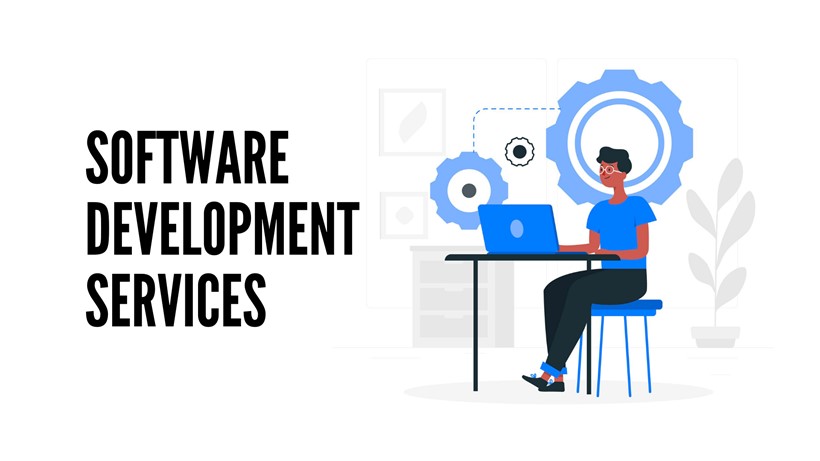
“Software development is the process of conceiving, specifying, designing, programming, documenting, testing, and bug fixing involved in creating and maintaining applications, frameworks, or other software components. Software development is a process of writing and maintaining the source code, but in a broader sense, it includes all that is involved between the conception of the desired software through to the final manifestation of the software, sometimes in a planned and structured process” Wikipedia
If you like the short explanation, here is what you should first have in mind. Software development services is a complicated process to design an application or software in order to meet a particular business or personal objective, goal or process. This process consists of various stages: Planning, Analysis, Product Design, Development & Implementation, Testing, Maintenance.
Software Development is an intriguing yet very complex thing which would normally go through a lot of processes. Each step should not be taken lightly since the success of a project depends on them. Here we will take you through the 7 Software Development Processes that Savvycom follows:
At the first stage, stakeholders, end users and the project team often gather and discuss in order to determine what exactly the requirements are. Then, the project team has to lay out how future software is designed and which programming languages are going to be used. Below are a few key point of this first and also important step:
The next step is to understand the technical requirements of this project. Every aspect of the software whether it’s an app, website redesign, or simply new feature, needs to solve customer’s problems.
As you move on from the planning phase and continue to fill out the statement of work, ask questions around this project, such as:
Once your development team gets the answers to these questions or once you have finished discussing with the outsourcing team, They can start to identify technical requirements, testing terms, and decide on a technology stack. This is also when you might start sprint planning (if you’re using an Agile software development process) or break down large tasks into more actionable steps.

Designing and Prototyping – One of the most important phase
With the requirements in place, it’s time to start designing what this software will look like and how it will function. Functionality and flow should be at most important from the start.
Depending on the software development process you’re following, this step might mean you create simple wireframes to show how interactions will work in the software, or make more full-fledged prototypes in order to test with users. Alternatively, you might decide you need more user feedback and do a design sprint to quickly get a feature or idea in front of your users.
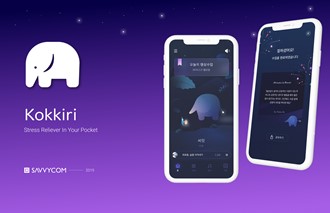
Software Development The Professional Way With Savvycom?
Our team can help you with the development of your application. Contact us to get a free initial consultation regarding your project and its estimation in terms of cost, timeline, and needed technical talent.
This stage is also known as “Programming” or “Coding”, at which computer programmers write program code in the suitable programming language. Then programmers conduct trials in order to detect errors and fix them until they’re error-free. This is the part when you would want to keep in touch with the development team as much as possible to ensure the pace of your project.
After the software is completely coded, it should be sent to the testing team before deployment, who gives feedback after using it. Although programmers should make sure there are not any errors existing, issues might not be obvious to them. Therefore, the testing team will use various test cases to have the software debug to ensure optimal functioning.

Jio Health – Leading Healthcare App in Vietnam built by Savvycom
With everything out of the way, it’s finally time to launch your software to all of your users. What we’re talking about here is pushing your code into production. A smart deployment plan plus an error free product will more than likely ensure the success of a project.
The Software Development Process isn’t over once your software is launched. It’s a “Software Development Lifecycle”, afterall. The ending of one phase is just the beginning of another, and that goes for post-launch as well.
Requirements and customer needs are always on the run. And as people begin to use your software, they’ll undoubtedly find bugs, request new features to be added, and ask for more or different functionality. Not to mention the basic upkeep and maintenance of your software to ensure uptime and customer satisfaction.
Finally, after the software is installed on the clients’ systems or devices. The programmers will carry out periodic maintenance in order to ensure programs can run smoothly and keep up with other apps of the same use overtime.
IT companies all come in different shapes and sizes. However, it’s possible to broadly classify them into two distinct types: service-based companies and product-based companies.

These are businesses that work on their own products and deliver them to end-users, which can be both businesses and individual customers. Such companies invest time and money into developing the out-of-the-box solutions which they can later configure and implement on the client’s side. They create software which can be later used by other companies to solve different business problems.
Google or Microsoft are excellent examples of product-based companies. They both offer a broad range of out-of-the-box solutions that can be customized and configured to match specific business needs. However, out-of-the-box solutions have their limitations, and licensing is often quite expensive, especially if your company doesn’t end up using all of the included components (which is a very common case).
Businesses that want to build a tailor-made solution that addresses their unique requirements usually turn to providers of custom software development services: the service-based companies.

Services Based Company – Top choice for Businesses in recent years
Such companies work directly for businesses and provide them with a wide range of services – for example, development of custom software projects or delivery of technical expertise in the form of team extension/argumentation, dedicated teams, or project teams.
Here are a few benefits of working with service-based companies:
The advantage of working with such companies is that you don’t need to worry about any overhead costs such as salaries, workstations, hardware, or software. It’s pretty much the same as setting up an Offshore Development Center.
Are you looking for a trusted Tech Partner?
Contact us for a free consultation on Software Development Services and you will get all of the insights from both the business and technical perspectives. Our software developers will advise you on the best approaches to the development process, as well as roughly estimate your project concept cost.

This is the primary area of focus for every software development service company. Such companies usually specialize in a few areas and types of software – for example, web development, mobile development, or fintech.
Software development service companies often specialize in specific technologies like machine learning or blockchain. They build solutions for various industries and types of organizations, from startups, through small and mid-size businesses (SMBs), to large enterprises.
Many software development vendors offer expertise in building data science solutions. Data is valuable resource organizations have, but make the most of it they need specialized software able to unlock insights from large data sets. This is where software development service companies come in. They built data science solutions such as analytical reports, dashboards, and Business Intelligence tools that help their clients implement data-driven decision-making.
Many software development service agencies provide their clients with advice for managing their software systems and architectures, building custom solutions, or driving innovation. The primary aim of consultancy services is taking the business to the next level by optimizing analytics, processes, and workflows with specialized software solutions.
Software development service companies also design and develop advanced websites and corporate systems used by enterprises to automate tasks and provide access to resources on the go thanks to the cloud technologies. Such corporate web-based systems help organizations increase productivity, facilitate workflow management, and boost their bottom line.
We rely on our technological expertise and specialized industry experience to develop any type of web, mobile, desktop, and hybrid app per your business requirements.
Comprehensive quality assurance is built into our custom software service model, but we can also provide on-demand QA and a suite of functional and usability software tests upon request.
Our application maintenance and modernization services are designed to ensure the scalability, performance, and sustainability of your entire software infrastructure as your business grows.
We build and implement custom APIs for all breeds of applications, helping to add functionality to your software systems and facilitate communication between your apps and others.
Our thorough threat audits help us identify your software infrastructure’s most pressing vulnerabilities, allowing us to integrate the encryptions, security services and access protocols you require.

Data Backup and Recovery are extremely important in a Covid World
Data Backup and Recovery have become some of the top priorities when it come to lockdown and social distancing due to the negative impact of Covid-19. We implement robust data backup and recovery strategies for cloud-based, on-premises and hybrid servers, designed to ensure the integrity of your data and the continuity of your business.
Our implementation specialists will work with your IT team to establish detailed software deployment objectives and timelines, covering configuration, testing, project governance, troubleshooting and more.
We provide holistic IT Infrastructure support, including help desk management, custom messaging and collaboration, network management and system administration services.
We perform cloud-based migrations, system upgrades and other vital software modernization services prioritizing system uptime and data integrity throughout an often daunting IT transition.
Integrating your applications is not just about making sure your various systems work together; it’s about doing so in a way that’s specific to your workflows, your departments and your business.
Our agile, end-to-end Application Lifecycle Management (ALM) model covers everything from conceptualization, concurrent front- and back-end coding, deployment, QA and more.
As software development service providers with 20 years of experience, you can trust us to put together a service level agreement that lays out expectations for costs, timelines and system functionality.
Are you looking for a Custom Software Development Team?
Contact us for a free consultation on Software Development and you will get all of the insights from our professional technical perspectives. Our Developers will advise you on the best approaches to the development process, as well as roughly estimate your project concept cost.
Nowadays, you may be so familiar with the word “smart” such as a smart house, smart car, smart TV, smartphone, etc. These amazing things are all products of IoT technology, which enables everything and everyone to connect with each other. It has been making our life easier and helping us with collecting any data that can be collected.
As for software development, there are more and more projects carried out in order to help people in communication and data analysis or to remotely control not only household devices, but also bulkier systems such as manufacturing lines and so on.

Traditional software development service involves a series of successive stages including manually writing code, preparing requirements, designing software, and testing to establish that the final product meets specifications.
Artificial intelligence (AI) disrupts this process by creating scalable and efficient workflows to drive productivity and reduce time-to-market. The use of AI in software development services is growing steadily, as according to the market research firm Tractica, the revenue from the application of AI tools worldwide is expected to reach $119B by 2025.
Augmented and virtual reality are perfect blends of the digital world and the physical elements to create an artificial environment. Apps which are developed using AR technology for mobile or desktop to blend digital components into the real world.
While both of them have the remarkable ability to alter our perception of the world, VR is more immersive, while AR provides more freedom for the user because it does not need to be a head-mounted display to operate (AR is often used via the phone camera).
Integrating AR and VR into software development helps make the product more realistic, therefore enhancing customer experience and earning brand love.

Put simply, Blockchain is a system of recording information in a way that makes it difficult or impossible to change, hack, or cheat the system.
Technically speaking, blockchain is essentially a digital ledger of transactions that is duplicated and distributed across the entire network of computer systems on the blockchain. Each block in the chain contains a number of transactions, and every time a new transaction occurs on the blockchain, a record of that transaction is added to every participant’s ledger. The decentralised database managed by multiple participants is known as Distributed Ledger Technology (DLT).
Due to its high security nature, Blockchain is often used for FinTech and Supply Chain software development services. The space for development of Blockchain is huge, as according to a report, the global blockchain market size is expected to grow from USD 3.0 billion in 2020 to USD 39.7 billion by 2025, at an impressive Compound Annual Growth Rate (CAGR) of 67.3% during 2020–2025.
A decision without clear, relevant and actionable objectives may create ambiguity and hinder your future success. Therefore, here are some questions that would help you organise your thoughts and produce a SMART goal:

In today’s context where outsourcing software development services has become one of the familiar patterns, many countries are upsurging as a destination for good services. In 2020 Vietnam is among if not the best country in preventing Covid-19 from spreading. In the report Spotlight on Vietnam, PwC forecasts that software development service outsourcing will be one of the most attractive sectors for foreign investment. In addition, prominent tech companies such as Intel, IBM, and Microsoft have been actively and continuingly endowing Vietnam. The trend is becoming more and more popular in Vietnam.
Also, the outstanding features of software development services in Vietnam is the cost efficiency in relation to low cost and lucrative preferential corporate income tax. Another aspects being Vietnam’s young population (45% of population are under 35 years of age), low attrition rate (6-8% in comparison with 20% in India), convenient location and the rising competency of engineers – meaning businesses could now outsource with a reasonable cost without having to settle for low quality.
https://www.scnsoft.com/
https://aaai.org/ocs/index.php/AAAI/AAAI17/help/view/intro/topic/000000/
Open Conference Systems (OCS) is an open source solution to managing and publishing scholarly conferences online. OCS is a highly flexible management and publishing system that can be downloaded for free and installed on a local Web server. It has been designed to reduce the time and energy devoted to the clerical and managerial tasks associated with managing a conference, while improving the record-keeping and efficiency of editorial processes. It seeks to improve the scholarly and public quality of conference publishing through a number of innovations, from making policies more transparent to improving indexing.
https://www.javatpoint.com/how-to-get-datasets-for-machine-learning
The key to success in the field of machine learning or to become a great data scientist is to practice with different types of datasets. But discovering a suitable dataset for each kind of machine learning project is a difficult task. So, in this topic, we will provide the detail of the sources from where you can easily get the dataset according to your project.
Before knowing the sources of the machine learning dataset, let’s discuss datasets.
A dataset is a collection of data in which data is arranged in some order. A dataset can contain any data from a series of an array to a database table. Below table shows an example of the dataset:
| Country | Age | Salary | Purchased |
|---|---|---|---|
| India | 38 | 48000 | No |
| France | 43 | 45000 | Yes |
| Germany | 30 | 54000 | No |
| France | 48 | 65000 | No |
| Germany | 40 | Yes | |
| India | 35 | 58000 | Yes |
A tabular dataset can be understood as a database table or matrix, where each column corresponds to a particular variable, and each row corresponds to the fields of the dataset. The most supported file type for a tabular dataset is “Comma Separated File,” or CSV. But to store a “tree-like data,” we can use the JSON file more efficiently.
Types of Dataset
To work with machine learning projects, we need a huge amount of data, because, without the data, one cannot train ML/AI models. Collecting and preparing the dataset is one of the most crucial parts while creating an ML/AI project.
The technology applied behind any ML projects cannot work properly if the dataset is not well prepared and pre-processed.
During the development of the ML project, the developers completely rely on the datasets. In building ML applications, datasets are divided into two parts:
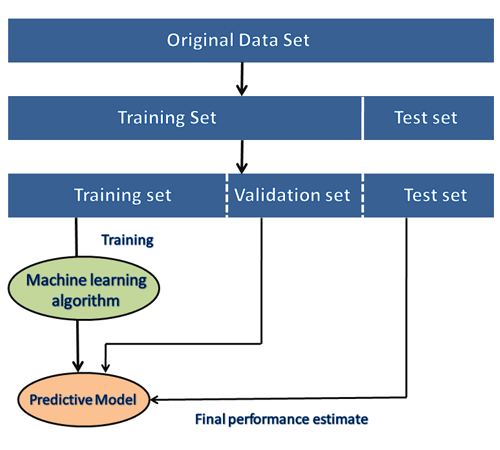
Below is the list of datasets which are freely available for the public to work on it:
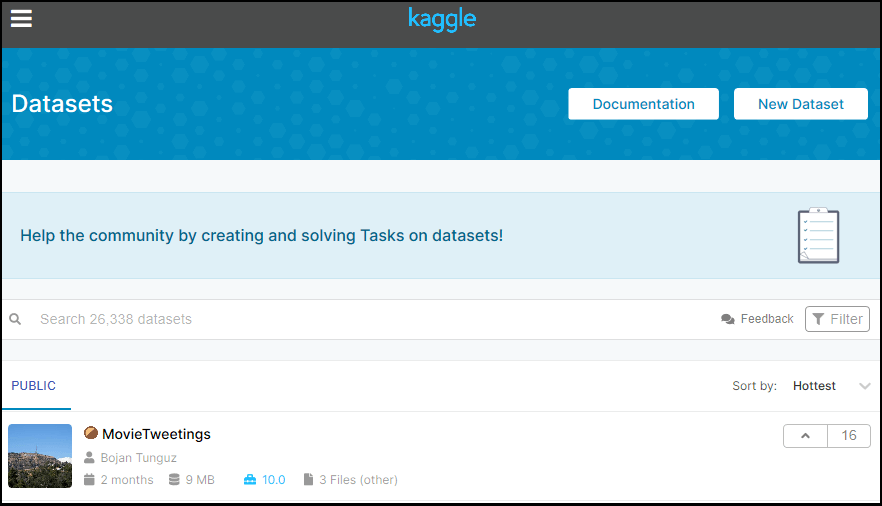
Kaggle is one of the best sources for providing datasets for Data Scientists and Machine Learners. It allows users to find, download, and publish datasets in an easy way. It also provides the opportunity to work with other machine learning engineers and solve difficult Data Science related tasks.
Kaggle provides a high-quality dataset in different formats that we can easily find and download.
The link for the Kaggle dataset is https://www.kaggle.com/datasets.
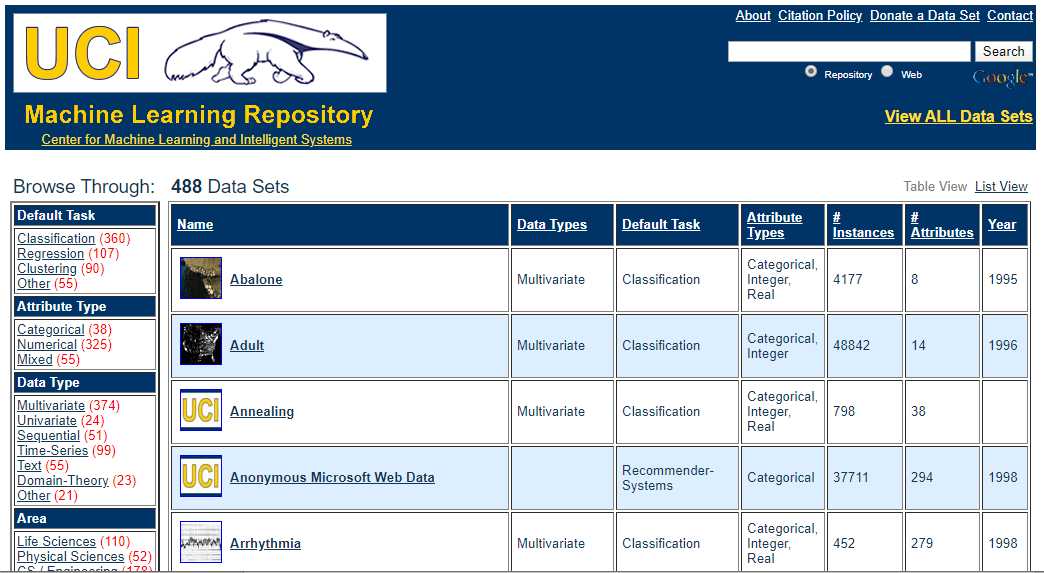
UCI Machine learning repository is one of the great sources of machine learning datasets. This repository contains databases, domain theories, and data generators that are widely used by the machine learning community for the analysis of ML algorithms.
Since the year 1987, it has been widely used by students, professors, researchers as a primary source of machine learning dataset.
It classifies the datasets as per the problems and tasks of machine learning such as Regression, Classification, Clustering, etc. It also contains some of the popular datasets such as the Iris dataset, Car Evaluation dataset, Poker Hand dataset, etc.
The link for the UCI machine learning repository is https://archive.ics.uci.edu/ml/index.php.
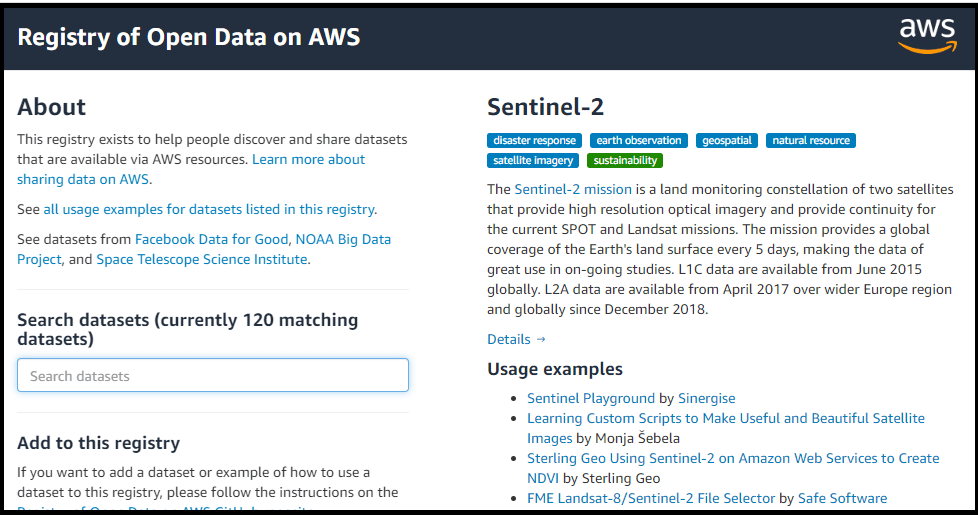
We can search, download, access, and share the datasets that are publicly available via AWS resources. These datasets can be accessed through AWS resources but provided and maintained by different government organizations, researches, businesses, or individuals.
Anyone can analyze and build various services using shared data via AWS resources. The shared dataset on cloud helps users to spend more time on data analysis rather than on acquisitions of data.
This source provides the various types of datasets with examples and ways to use the dataset. It also provides the search box using which we can search for the required dataset. Anyone can add any dataset or example to the Registry of Open Data on AWS.
The link for the resource is https://registry.opendata.aws/.
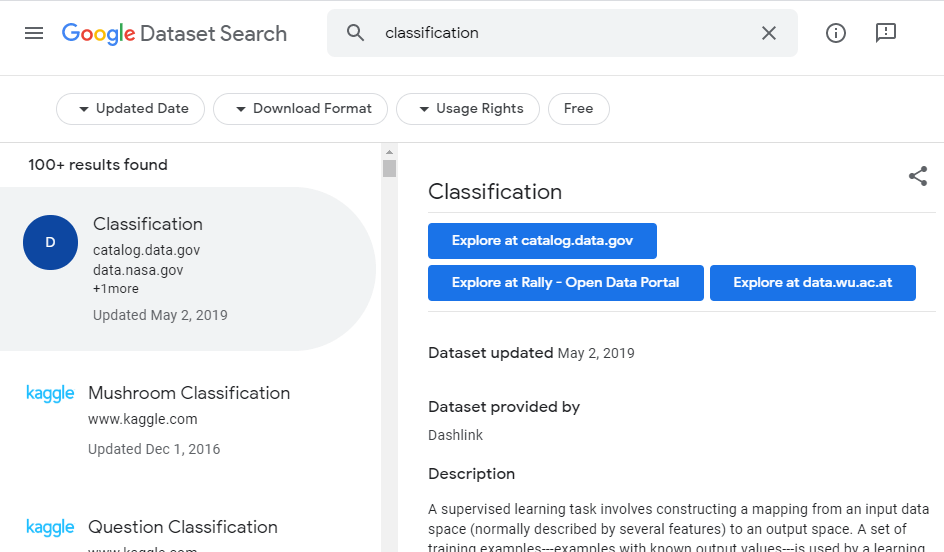
Google dataset search engine is a search engine launched by Google on September 5, 2018. This source helps researchers to get online datasets that are freely available for use.
The link for the Google dataset search engine is https://toolbox.google.com/datasetsearch.
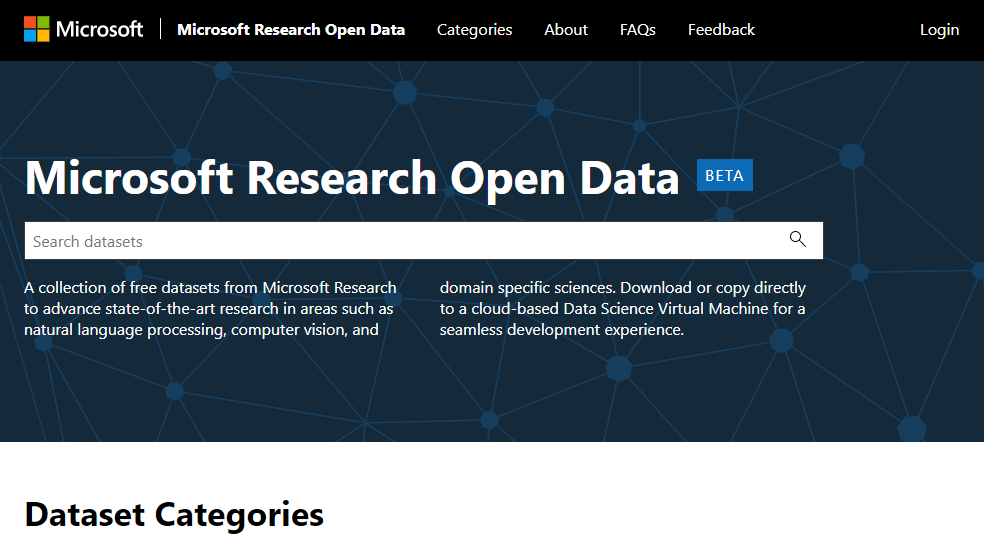
The Microsoft has launched the “Microsoft Research Open data” repository with the collection of free datasets in various areas such as natural language processing, computer vision, and domain-specific sciences.
Using this resource, we can download the datasets to use on the current device, or we can also directly use it on the cloud infrastructure.
The link to download or use the dataset from this resource is https://msropendata.com/.
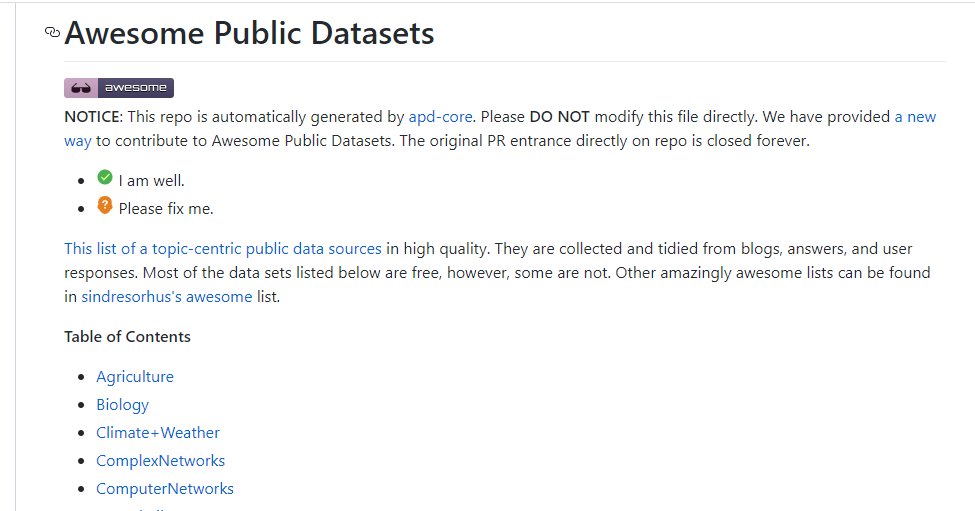
Awesome public dataset collection provides high-quality datasets that are arranged in a well-organized manner within a list according to topics such as Agriculture, Biology, Climate, Complex networks, etc. Most of the datasets are available free, but some may not, so it is better to check the license before downloading the dataset.
The link to download the dataset from Awesome public dataset collection is https://github.com/awesomedata/awesome-public-datasets.
There are different sources to get government-related data. Various countries publish government data for public use collected by them from different departments.
The goal of providing these datasets is to increase transparency of government work among the people and to use the data in an innovative approach. Below are some links of government datasets:
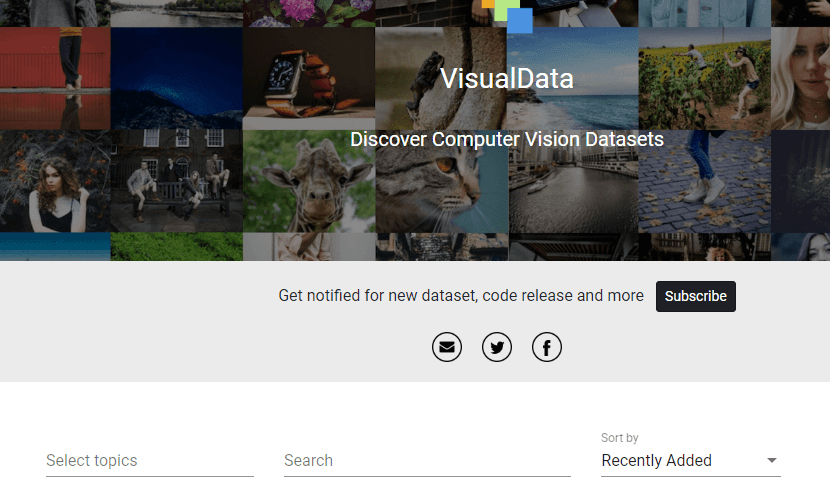
Visual data provides multiple numbers of the great dataset that are specific to computer visions such as Image Classification, Video classification, Image Segmentation, etc. Therefore, if you want to build a project on deep learning or image processing, then you can refer to this source.
The link for downloading the dataset from this source is https://www.visualdata.io/.
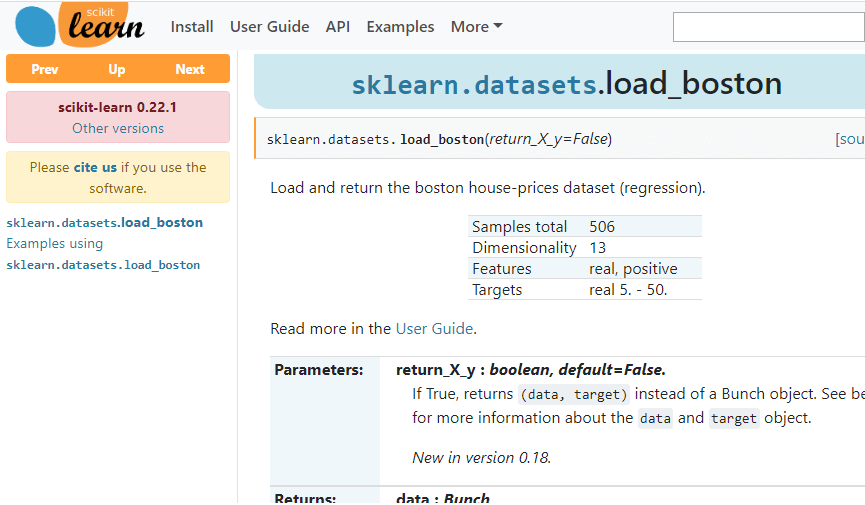
Scikit-learn is a great source for machine learning enthusiasts. This source provides both toy and real-world datasets. These datasets can be obtained from sklearn.datasets package and using general dataset API.
The toy dataset available on scikit-learn can be loaded using some predefined functions such as, load_boston([return_X_y]), load_iris([return_X_y]), etc, rather than importing any file from external sources. But these datasets are not suitable for real-world projects.
The link to download datasets from this source is https://scikit-learn.org/stable/datasets/index.html.
http://49.248.66.26/
Welcome to DSpace, Koha, VuFind & Drupal LibLiveDVD
Dr. Sunita Barve
CSIR-National Chemical Laboratory, Pune, India
and
ARD Prasad
DRTC, Indian Statistical Institute, Bengaluru, India
This release of LibLiveDVD is configured using Lubuntu 16.04.2 (LTS)-64bit, DSpace 6.0, Koha 16.11.06, Vufind v3.1.2 and Drupal 7.54.
DSpace
DSpace Mirage2 Interface (http://localhost/xmlui)
DSpace Admin login: library@localhost
Password: library
For Further Information
Koha
Koha admin (http://localhost/kohaadmin)
Koha OPAC (http://localhost/opac)
Koha admin login: koha_library
Koha admin password: library
For Further Information
Vufind
To access VuFind click http://localhost/vufind
Drupal 7
Run Drupal
Drupal Database Name: drupal7
Drupal User Name: drupal
Drupal Database Password : library
Web Mail Client
Squirrelmail
You may try: Login: dspace
password: library
Multi-Lingual Input
To configure MultiLingual Input
Logins and Passwords for shell and databases
password for dspace: library
password for koha database in mysql : library
Login for mysql admin user: root ; Password: library
Login for drupal database in mysql user:drupal, database:drupal7, password:library
In a 2014 blog post, Lorcan Dempsey (OCLC Vice President, Membership and Research, Chief Strategist) wrote about Research Information Management Systems (RIMS) as a potential new service category for libraries. RIMS collect and store structured data about faculty research and scholarly activities for one institution, with the intention of repurposing the information in a variety of ways. Academic institutions in the U.S. and Canada are implementing systems such as Activity Insight, Pure, Converis, and Symplectic Elements, which track publications and scholarly activities of faculty. These systems give an overall picture of the research and scholarly enterprise of an institution, and they offer faculty tools for collaborating, publicizing their work, complying with policies (such as open access policies), and creating reports for faculty annual review or promotion and tenure.
It is important to note that RIMS is not the only name by which these systems are known. In Europe, where these systems were first developed and used, a more common term is Current Research Information Systems (CRIS). Other terms include “profile system” or “networking tool” and variations thereof.
Several RIMS platforms are available and offer varying options. Many tools have particular strengths in one aspect of research information management, such as publication and grants management, faculty activity reporting, or collaboration and networking for research and scholarship. A useful Wikipedia article compares systems and provides information on their data sources and formats, interoperability and integration, functionality, controlled vocabulary or ontologies, and bibliometrics.
These systems are distinguished from other web-based networking sites such as LinkedIn or Google Scholar in terms of their authority (RIMS ingest data from authoritative sources) and metrics tools (such as Journal Impact Factor or Altmetrics). They also employ standards or common data formats for interoperability, enabling importation of external data and reuse of system data, such as for CV’s and biosketches, or to populate the institutional repository.
Below are some of the more well-known RIMS in the U.S. and Canada. Many platforms offer more functionality than the descriptions below imply, and providers are regularly adding new features and modules. Some institutions choose to use one platform, while others use a combination of platforms for different purposes. Interoperability standards allow for multiple systems to communicate or export data to other systems.
Converis, Pure, and Symplectic Elements offer robust functionality for publication and grant award management, and they are increasingly being used for faculty activity reporting.
Digital Measures and Data180 offer platforms for faculty activity reporting and CV creation.
Profiles and VIVO are designed for research networking and collaboration, providing a web-based snapshot of faculty scholarship in an online profile and tools for finding expertise within research areas.
Standards for RIMS are evolving. The CRIS community in Europe uses a common standard, CERIF (Common European Research Information Format), to support exchange of data between RIMS. The Consortia Advancing Standards in Research Administration Information (CASRAI) has developed a dictionary of common terms used in research administration information. In addition, RIMS can provide metrics from providers like Thomson Reuters (Research Analytics) and Elsevier (Snowball Metrics), or emerging alternatives (such as Altmetric). RIMS can also use ORCID (Open Researcher and Contributor ID) identifiers for author disambiguation.
RIMS benefit academic institutions through both their efficiency and their effectiveness. Providing a central repository of information about faculty scholarship and research activities, from which multiple outputs may be exported, allows for efficient capture and reuse of faculty data. RIMS can help increase the visibility of scholarship on campus, show trends in funding or research areas, and identify expertise for grant applications, interdisciplinary research collaboration, or campus communications. By capturing data from authoritative sources and offering tools for analytics and metrics, RIMS also address a strategic need on many campuses to show the effectiveness of academic programs.
However, adopting RIMS can be a slow process. Outside of grants and publications, much of the information an institution may want to capture about their faculty does not have a source and requires manual entry (for example, honors and awards, students mentored, journal editorships, or society memberships). Non-federal grant data is difficult to capture automatically. In the area of publications, coverage for many disciplines (especially humanities and social sciences) or for particular publication types (especially grey literature such as lectures, technical reports, or white papers) is not complete in the available automated data sources. There may also be organizational or political roadblocks: resistance from faculty, a lack of resources for data entry, or funding issues.
Libraries implement these systems in a number of ways, from tracking publications, to creating links to institutional repositories, to leadership, training and funding. In some cases, the library’s work with RIMS is an extension of the scholarly output assessment services already provided. For example, the library may already be involved in research data management, operating a repository, or supporting institutional review and accreditation. Library involvement in RIMS implementation is a natural extension of all of these roles, and offers an opportunity for the library to advocate for positive changes in scholarly communication, such as open access or alternative measures of research impact. However, the library may also easily fall into a purely administrative role with RIMS implementation. The earlier the library can establish a place at the table, the better the chance it has in adopting a leadership and advocacy role.
Börner, Katy, Michael Conlon, Jon Corson-Rikert, and Ying Ding. 2012. VIVO: A semantic approach to scholarly networking and discovery. Morgan & Claypool Publishers.http://www.morganclaypool.com/doi/abs/10.2200/S00428ED1V01Y201207WBE002.
Bryant, Rebecca, Ruth Allee, Kate McCready, and Julie Speer. 2015. “Facilitating researcher discovery across all disciplines : challenges and strategies for implementing campus researcher profiles for humanists and social scientists.” Digital Library Federation (DLF), October 26. http://hdl.handle.net/2429/55689.
Chin Roemer, Robin, and Rachel Borchardt. 2014. “Keeping up with… Altmetrics.” Accessed February 29, 2016. http://www.ala.org/acrl/publications/keeping_up_with/altmetrics.
Dempsey, Lorcan. 2014. “Research information management systems – a new service category?” Lorcan Dempsey’s Weblog. October 26. Accessed February 29, 2016. http://orweblog.oclc.org/research-information-management-systems-a-new-service-category/.
Jacobs, Neil. 2015. “Research information management.” In Digital Information Strategies: From Applications and Content to Libraries and People, by David Baker and Wendy Evans, 57-69. Chandos Publishing.
Kennan, Mary Anne, Sheila Corrall, and Waseem Afzal. 2014. ““Making space” in practice and education: research support services in academic libraries.” Library Management 35 (8/9): 666-683. Accessed March 2, 2016. doi:http://dx.doi.org/10.1108/LM-03-2014-0037.
MacColl, John, and Michael Jubb. 2011. “Supporting Research: Environments, Administration and Libraries.” OCLC Research. Accessed March 2, 2016. http://www.oclc.org/content/dam/research/publications/library/2011/2011-10.pdf.
Ribeiro, Ligia, Pablo de Castro, and Michele Mennielli. 2016. “Final report: EUNIS – EUROCRIS joint survey on CRIS and IR.” euroCRIS. Accessed March 7, 2016. http://www.eurocris.org/sites/default/files/files/cris-report-ED(1).pdf.
Russell, Rosemary. 2012. “Adoption of CERIF in Higher Education Institutions in the UK: A Landscape Study.” UKOLN. March 22. Accessed March 2, 2016. http://opus.bath.ac.uk/30979/3/CERIF_UK_landscape_report_v1.1.pdf.
Wikipedia. n.d. “Comparison of research networking tools and research profiling systems.” Wikipedia. Accessed February 29, 2016. https://en.wikipedia.org/wiki/Comparison_of_research_networking_tools_and_research_profiling_systems.